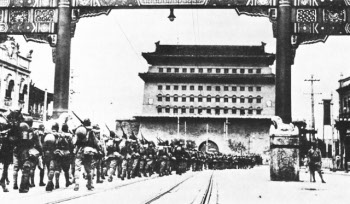![]() The Pacific War Online Encyclopedia
The Pacific War Online Encyclopedia
|
| Previous: Mountbatten, Louis | Table of Contents | Next: Mu Ting-fang |

U.S. Army. Via ibiblio.org
The movement of military forces is a major element of tactics. Formations must be able to move to the combat zone, to advance against the enemy when attacking, and to retreat
when it is impossible or unwise to continue holding a position. The
force with greater mobility can usually chose the time and place of
battle, with all the tactical advantages that follow.
The movement of military formations in combat is distinct from the movement of supplies and reinforcements or even the deployment of formations to the combat zone, which fall under the heading of logistics.
Land Movement. The Japanese Army heavily emphasized marching in its training, and Japanese infantry were capable of a sustained advance on typical level roads of 15 to 25 miles (24 to 40 km) per day. Cavalry could advance 25 to 37 miles (40 to 60 km) per day, motorized units could advance 60 to 75 miles (100 to 120 km) per day, and tank forces could advance 50 to 60 miles (80 to 100 km) per day. Hourly rates of advance in daytime were 2.5 miles per hour (4 km/h) for infantry, 4 to 6 miles per hour (6 to 10 km/h) for cavalry, 7 to 12 miles per hour (12 to 20 km/h) for motorized units, and 7 to 10 miles per hour (12 to 16 km/h) for tank units. Infantry were permitted a short rest every hour.
The Japanese were particularly hardy at marching through jungle or other difficult terrain, where they sometimes achieved a rate of advance of 10 to 12 miles (16 to 19 km) per day. Japanese troops marching through jungle were permitted 20 minutes of rest for every 20 minutes of marching.
Movement at night is more difficult. The hourly rate of movement on roads was reduced about 75% for infantry and cavalry, and by as much as a factor of three for vehicles and tanks running without lights.
These figures are all considerably less than the nominal maximum
speed of the force involved. A top athlete can sprint at over 20 miles
per hour (30 km/h), but only for a very brief time and not while
carrying any equipment. An athlete can run a marathon (about 26 miles or
42 km) in less than three hours, for an average speed of around 8 miles
per hour (14 km/h), but, again, not while carrying any equipment, and
he would be quite incapable of combat and the end of his run. The
nominal sustained rate of march of about 2 miles per hour (3 km/h) for
infantry assumed a fairly heavy equipment load and the need for the
infantry to be capable of fighting at the end of the march. Heavy trucks
were capable of up to 55 miles per hour (89 km/h) running flat out, but
this was almost never advisable due to wear and the potential for
accidents. The same was true, though to a lesser extent, of tanks. Tanks
were also mechanically less reliable than trucks and tended to quickly
wear out treads on hard roads, though they had good off-road mobility.
For long marches, tanks were best moved by tank carrier, but these were
in short supply in the Pacific.
Movement by rail could take place at sustained speeds of up to 15
miles per hour (24 km/h) but involved significant loading and unloading
times. In addition, rail movement was highly hazardous close to the
front line, as rail cars made splendid targets for artillery.
Sea Movement. Cargo ships typically could advance about 240 nautical miles (440 km) a day. Transports, which were usually faster, could do 360 nautical miles (660 km). Warships could sometimes move much faster, up to 35 knots for modern destroyers, but consumed fuel prodigiously while doing so. Economic cruising speed for warships was more typically around 15 knots, giving about the same speed of advance as transports. The submarines of the Pacific War were designed for sustained speeds of at least 17 knots (and more typically 20 knots), allowing them to maneuver ahead of convoys, but were very slow when submerged. A submarine could make perhaps 8 knots underwater, but rapidly exhausted its batteries at this speed. A few small craft, such as PT boats, could sustain speeds in excess of 40 knots.
Cargo ships were designed with long enough ranges to cross oceans,
but fuel supply was a constant concern for warships that had to be ready
for high-speed operations in their combat areas. The development of
at-sea refueling was meant to break the shackles of limited range, but
was successful mostly in the hands of the Americans, whose accomplishments were never matched by either the British or the Japanese.
Air Movement. As with warships, most aircraft could fly much faster than their most economical cruising speed.
The fastest aircraft of the Pacific War had a maximum speed of about 440
miles per hour (700 km/h) but cruising speed was rarely much in excess
of 250 miles per hour (400 km/h). Transport aircraft typically had a cruising speed of
less than 200 miles per hour (230 km/h) and had less excess speed
capacity built into them than combat aircraft. Aircraft range was also
important, varying from around 900 to 2000 miles (1450 to 3000 km) for
transport aircraft. Transport of supplies and men by air was rapid,
flexible, and hideously expensive.
References
"Handbook on Japanese Military Forces" (1944-9-15)
The Pacific War Online Encyclopedia © 2014 by Kent G. Budge. Index